AUD ARS ALL BRL BGN BOB COP CNY

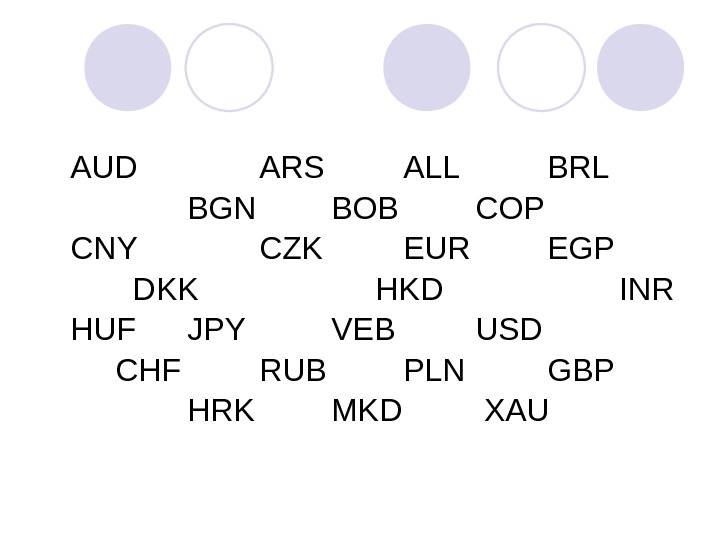
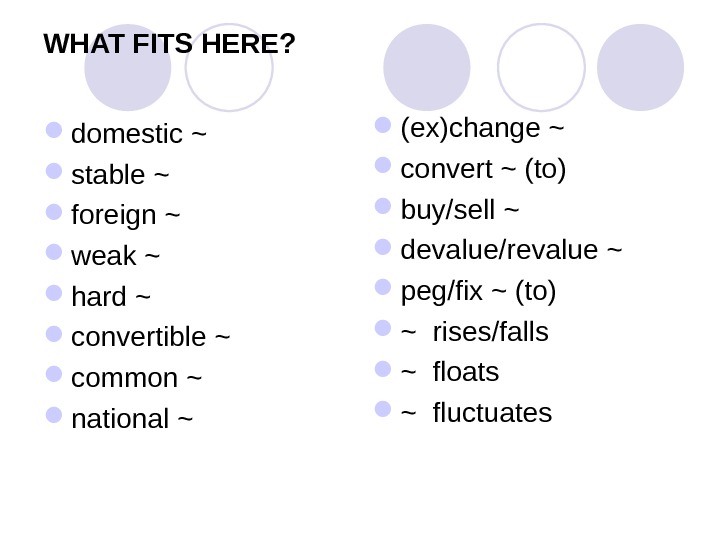
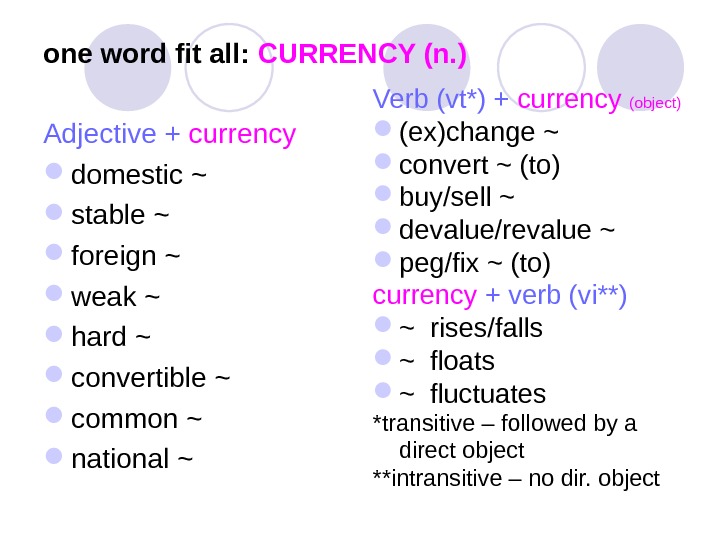
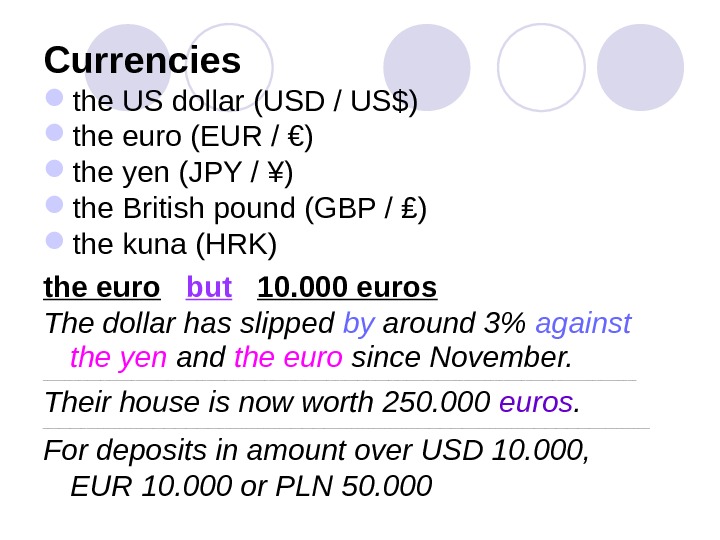
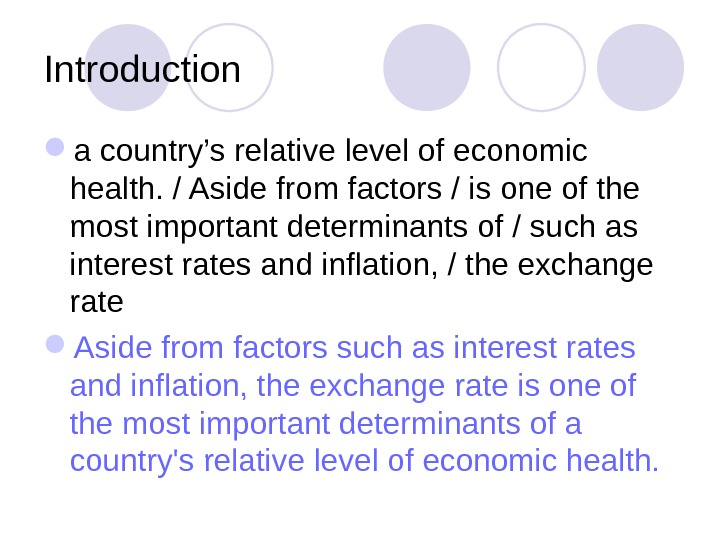
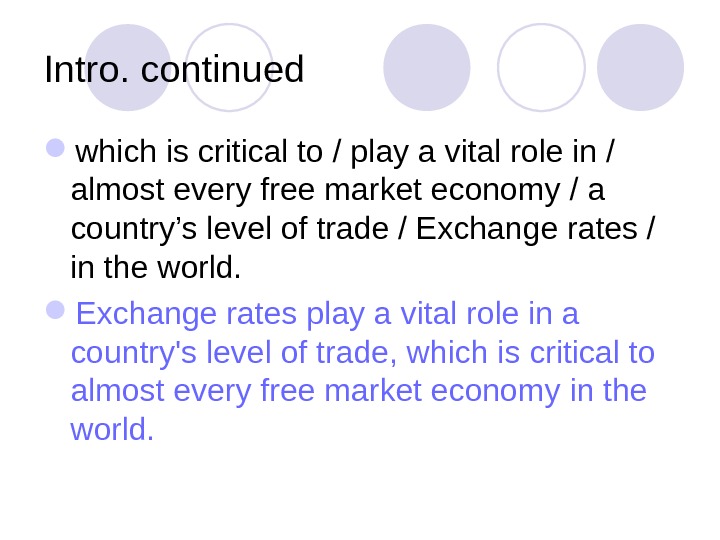
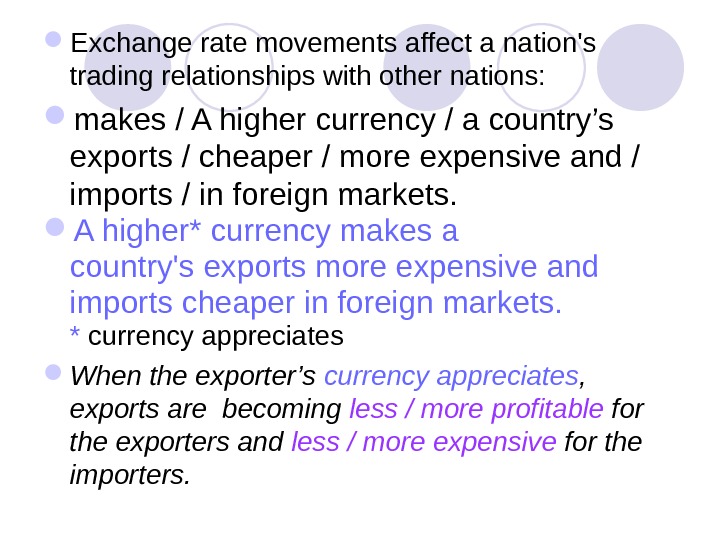
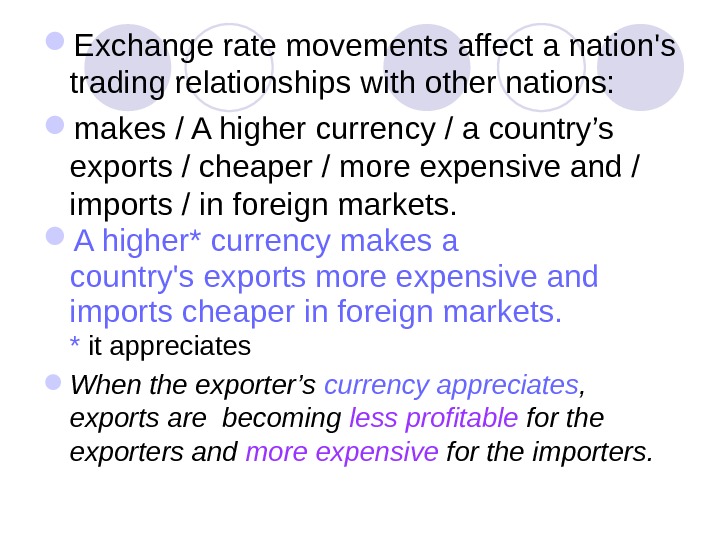
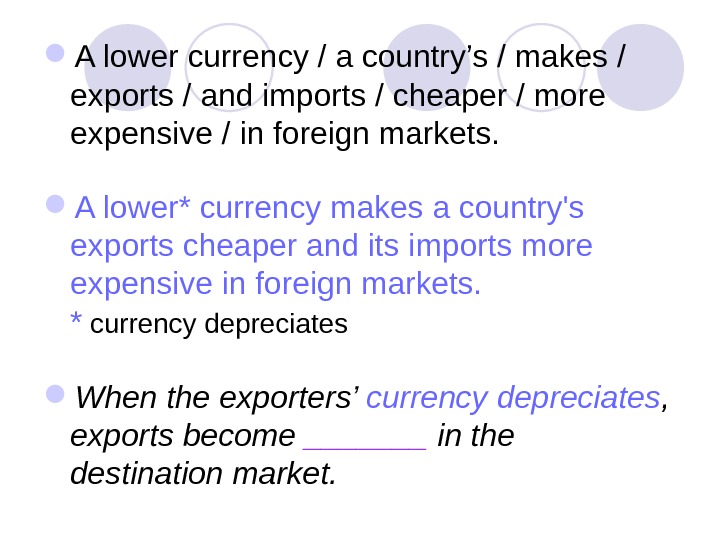
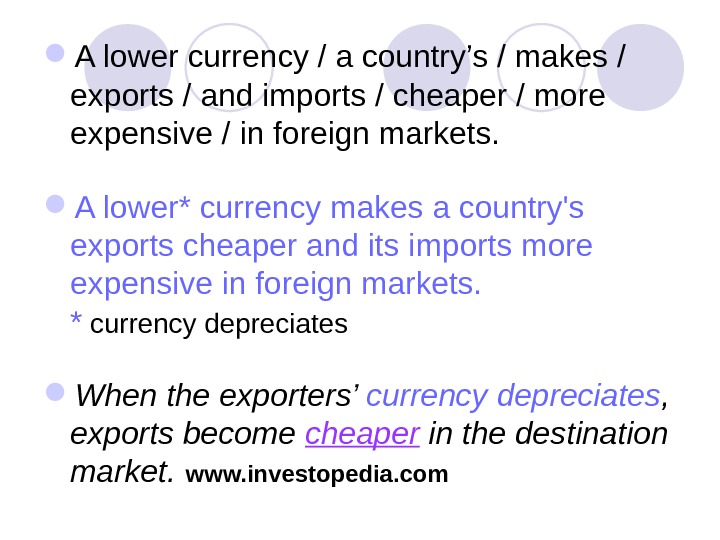
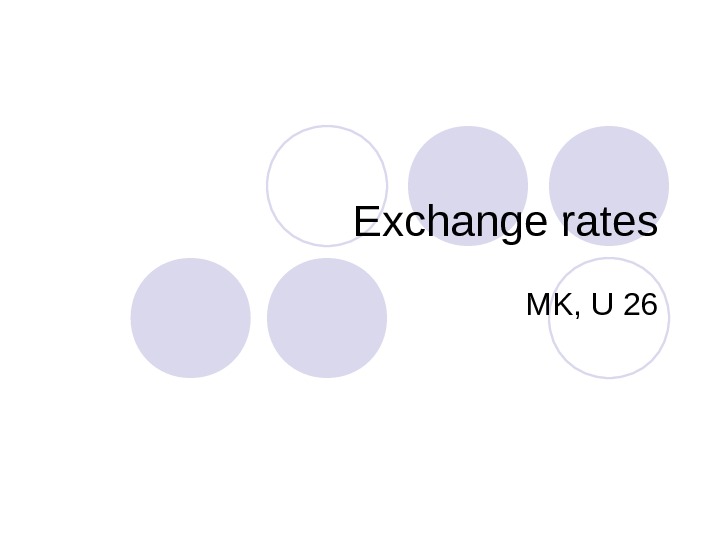
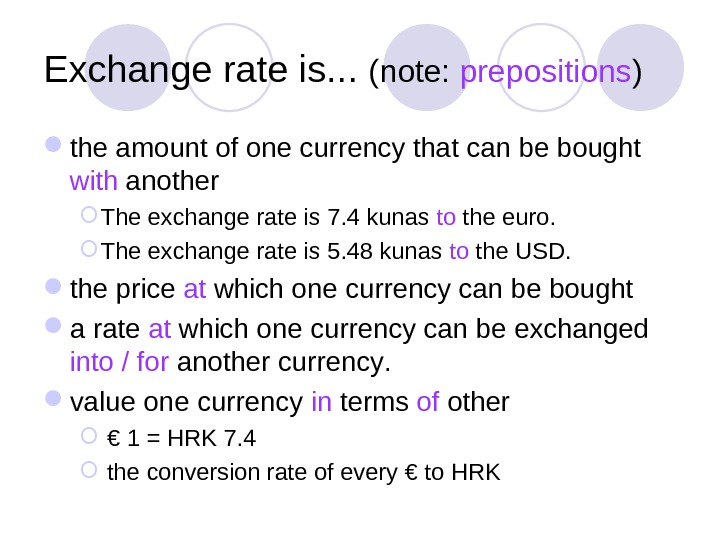
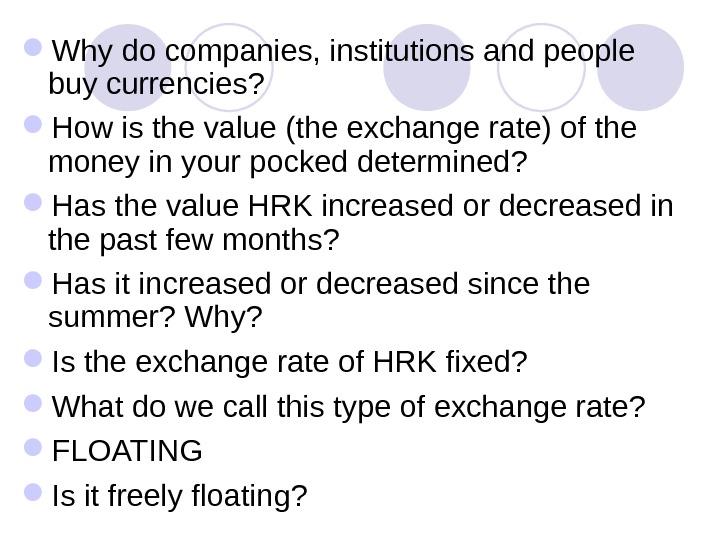
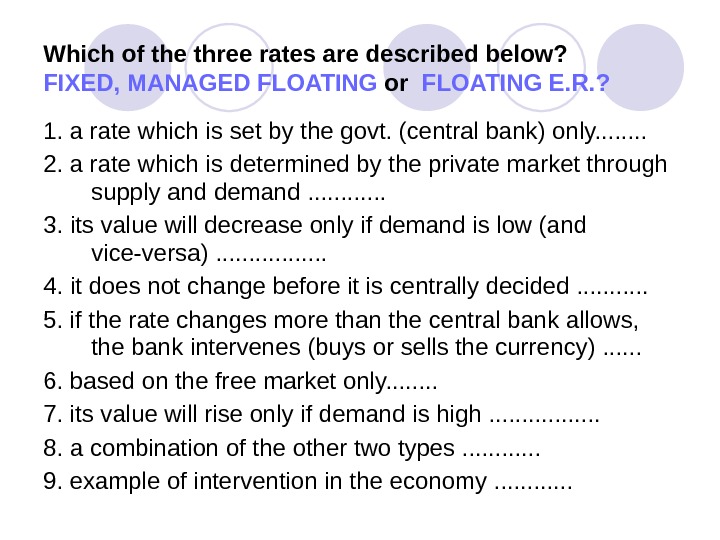
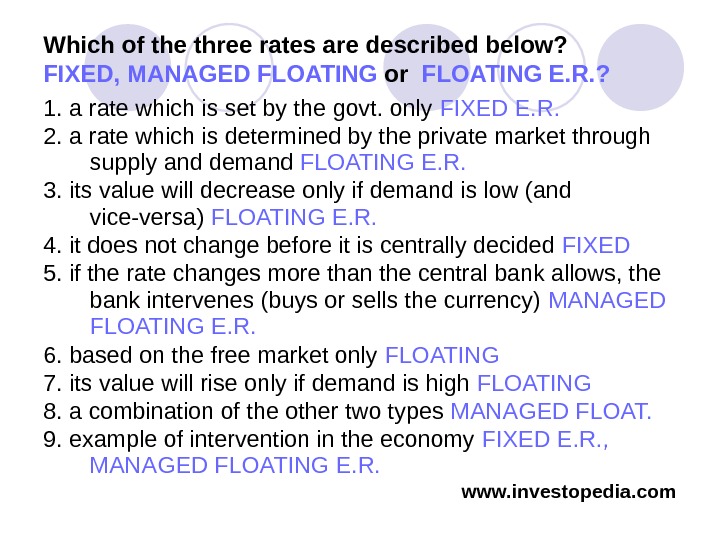
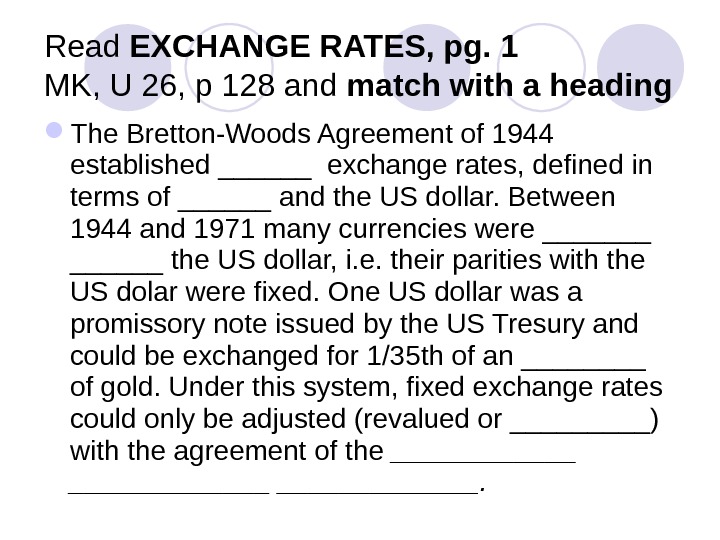

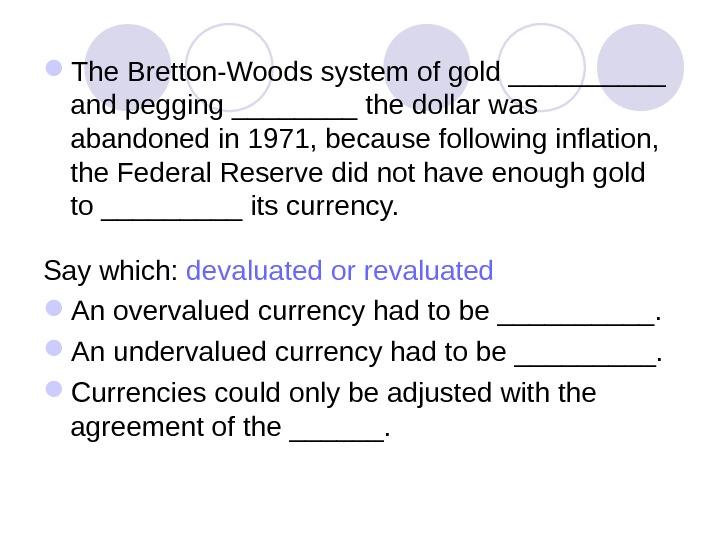
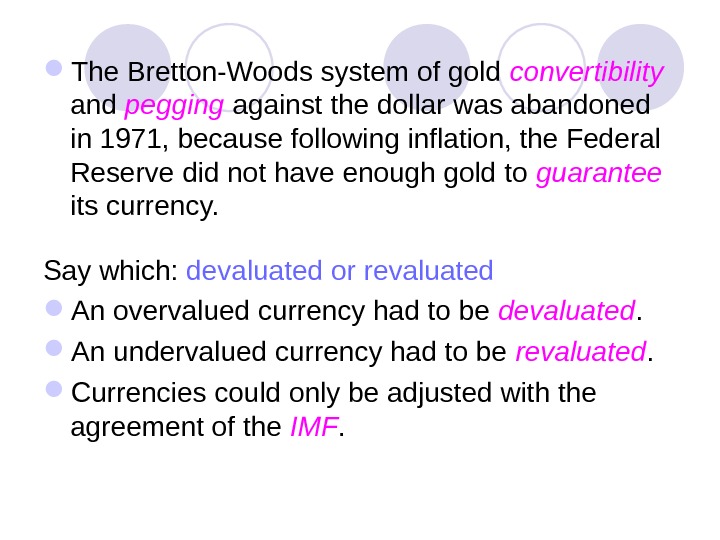

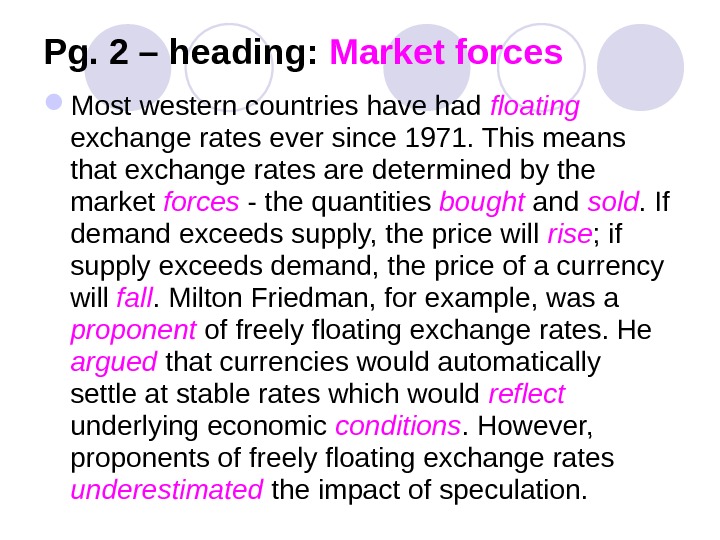
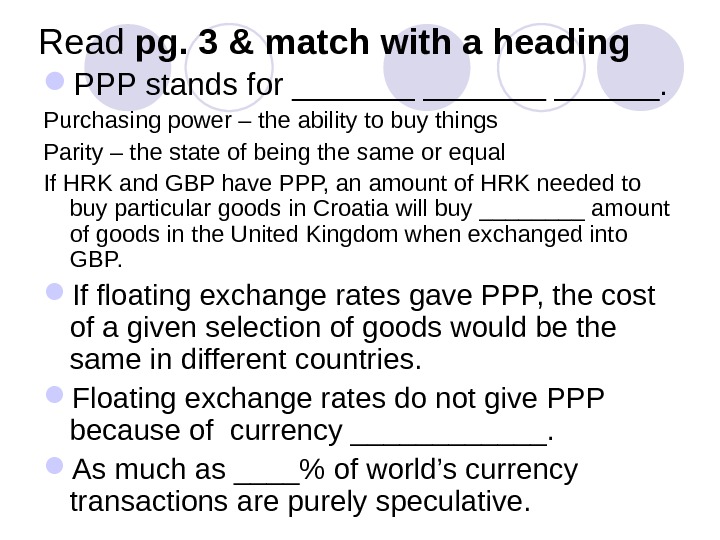
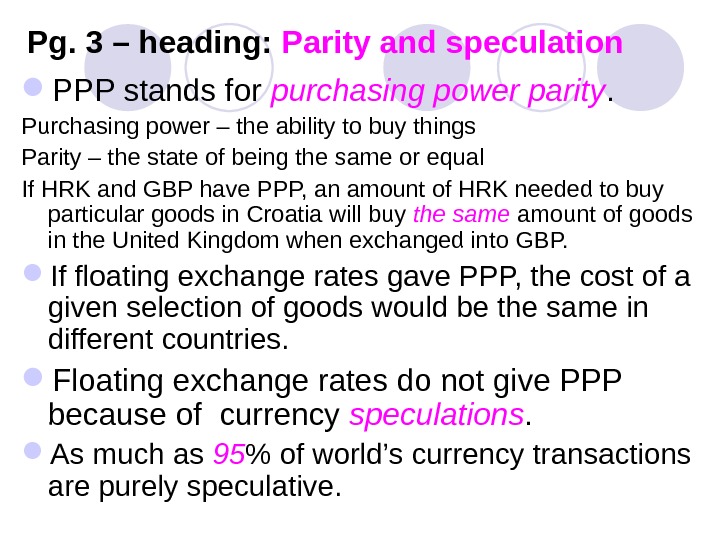
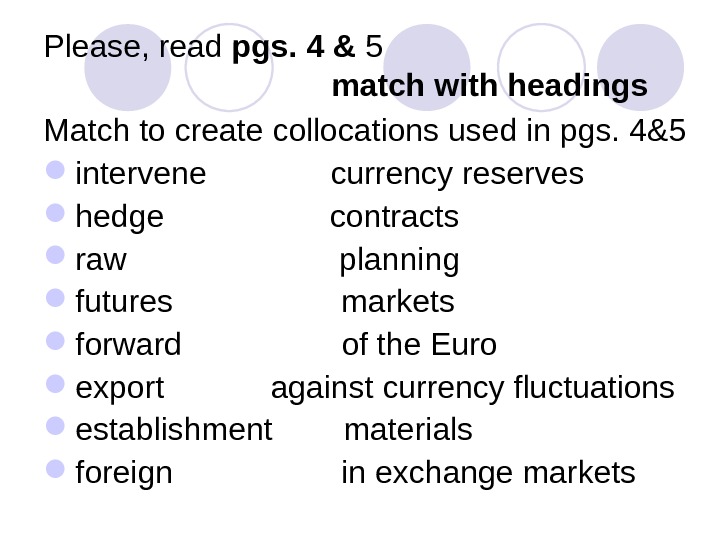
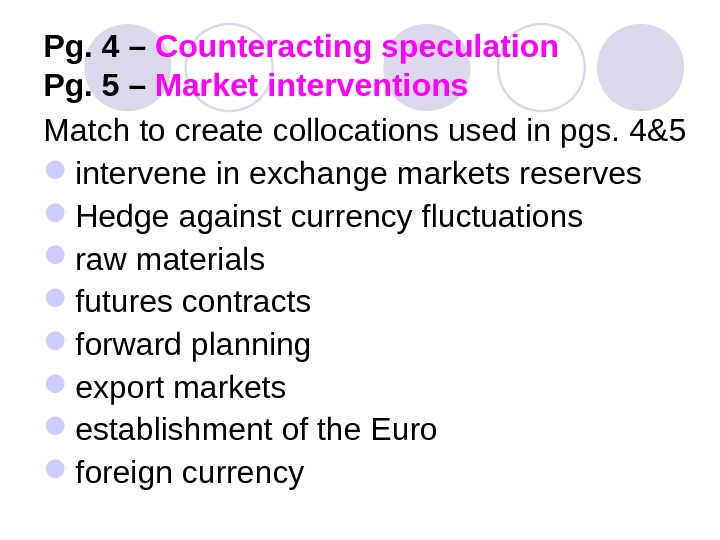


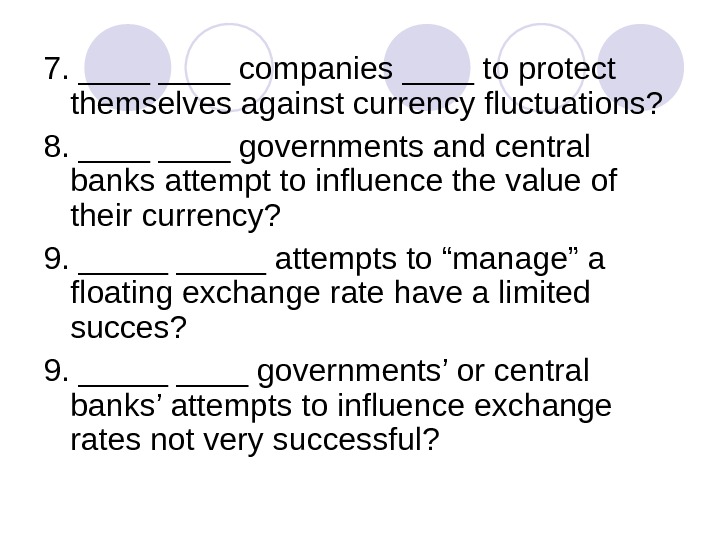
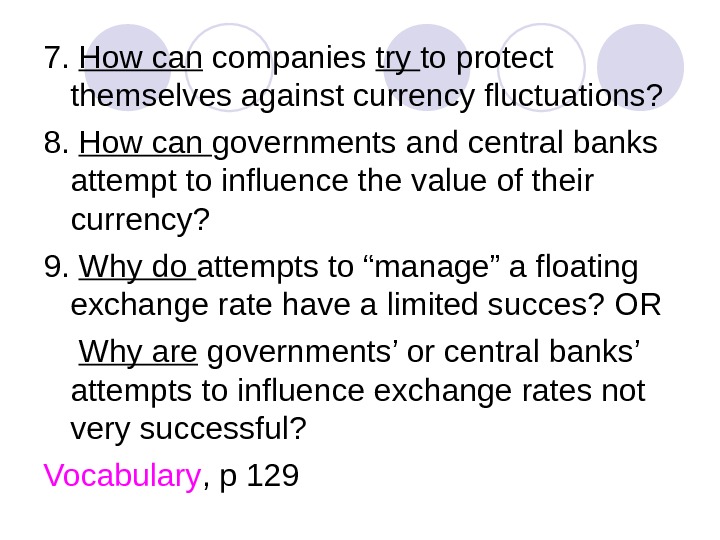
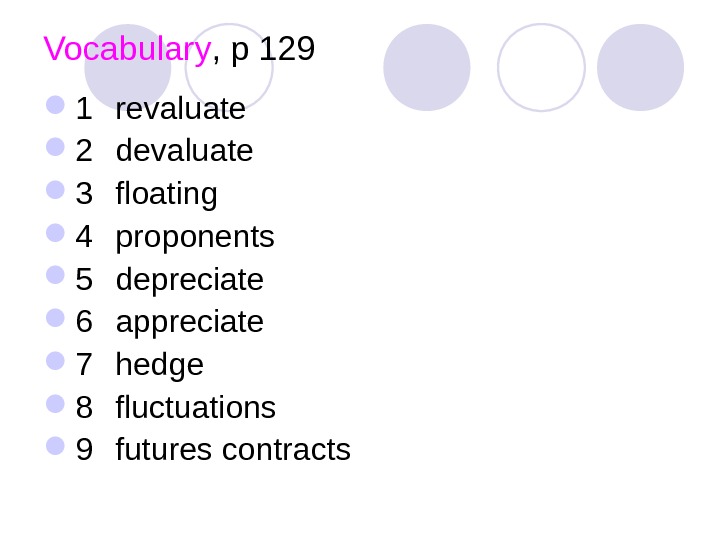

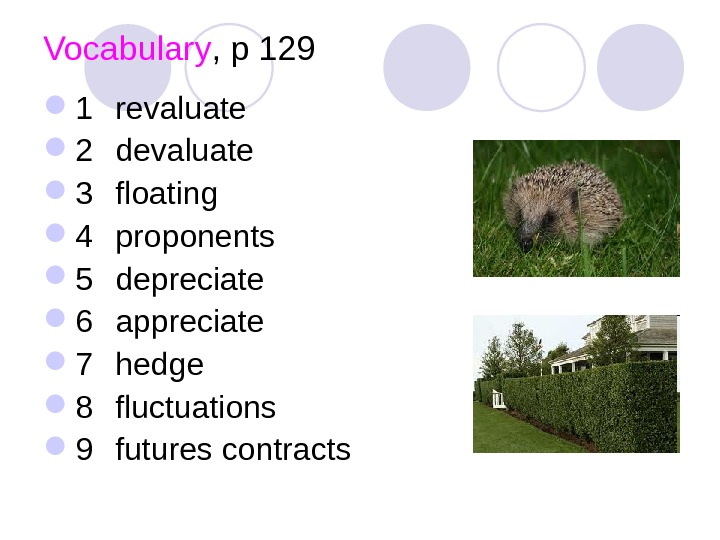
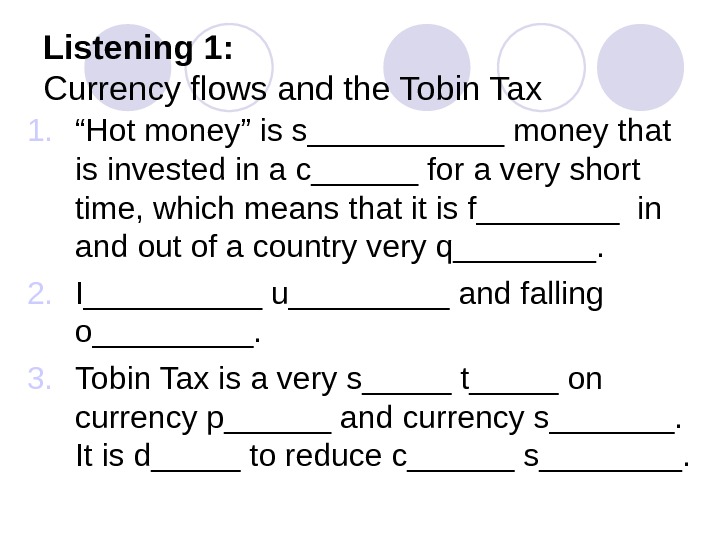
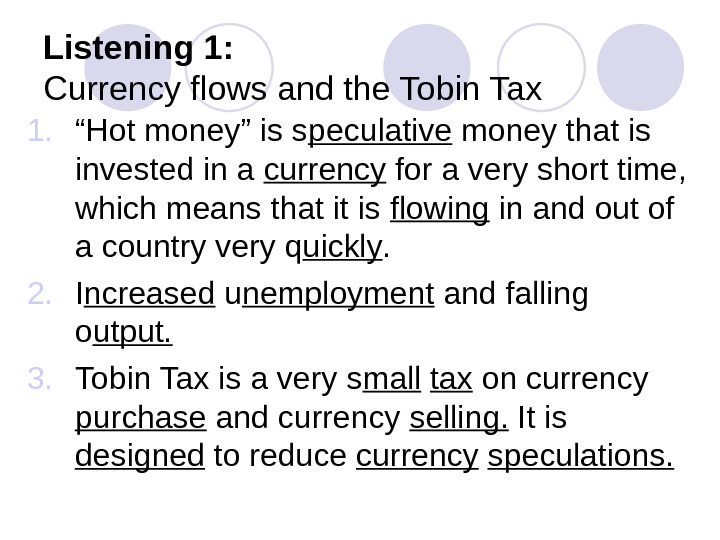
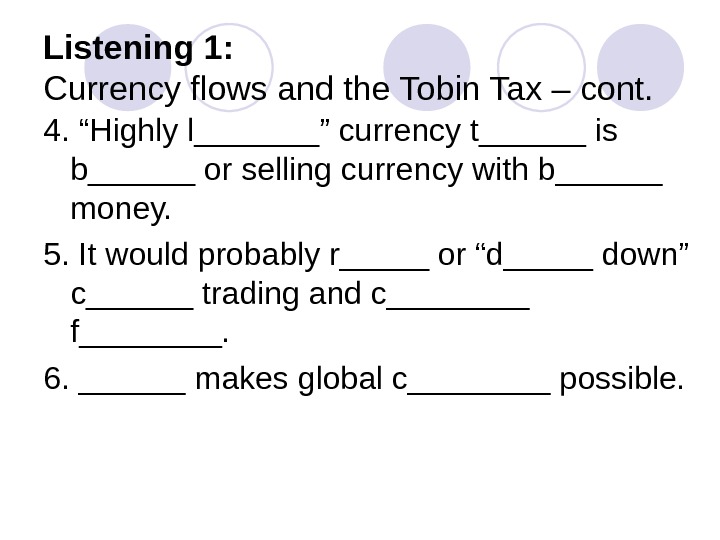
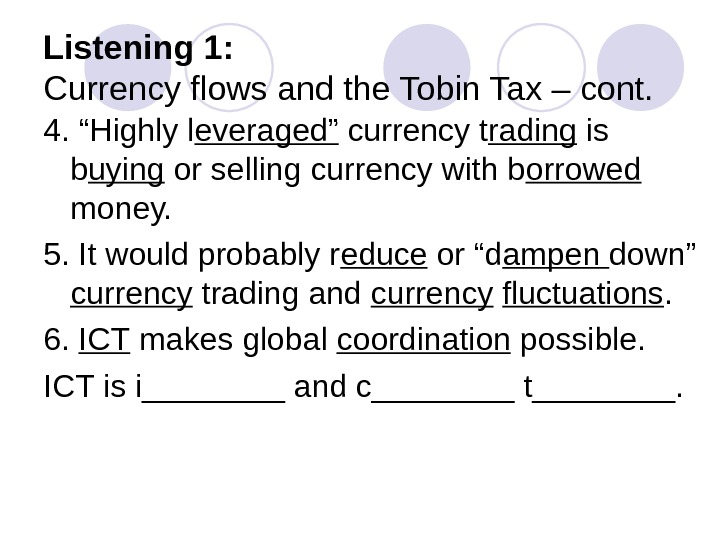
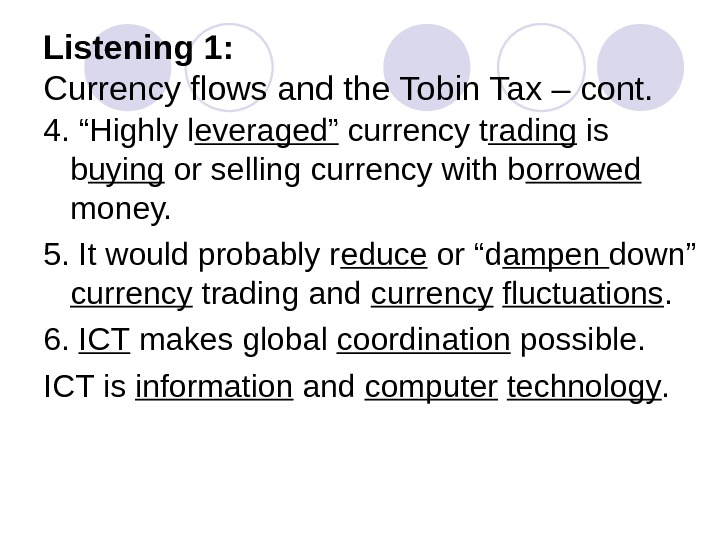
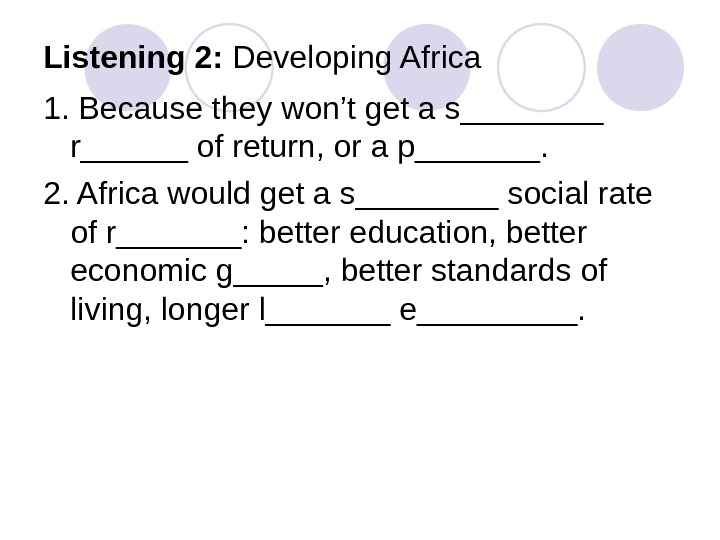
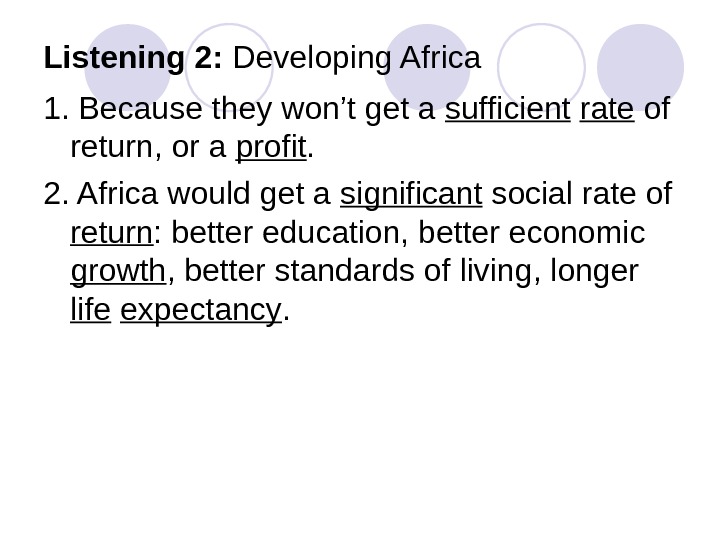
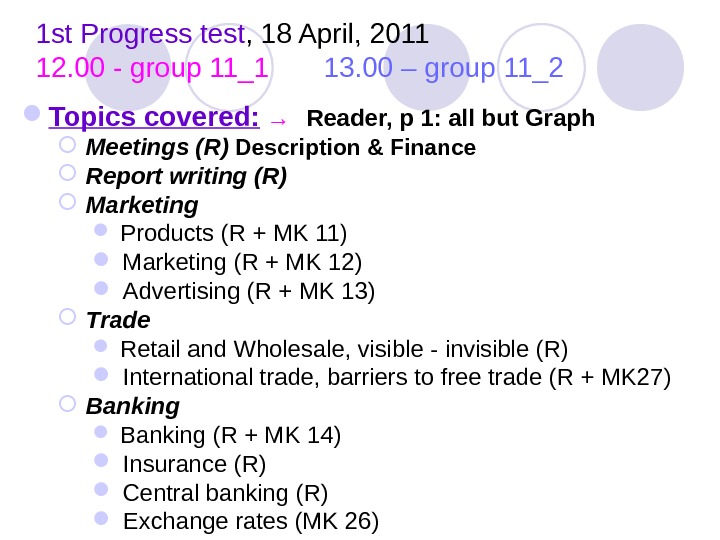
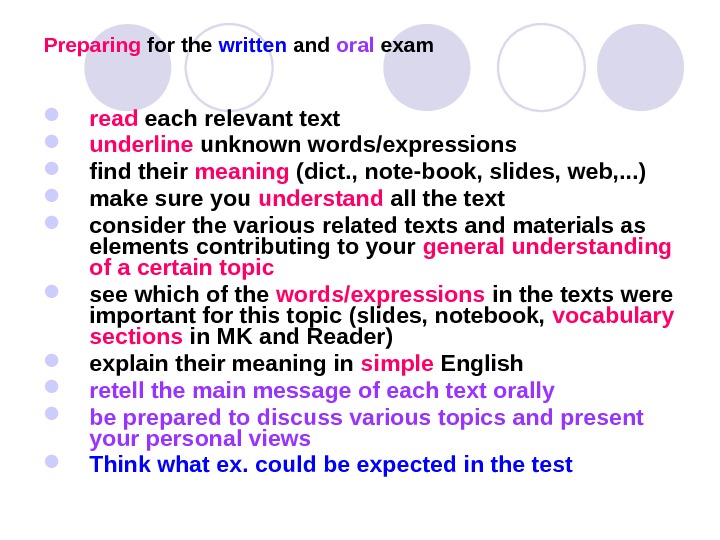
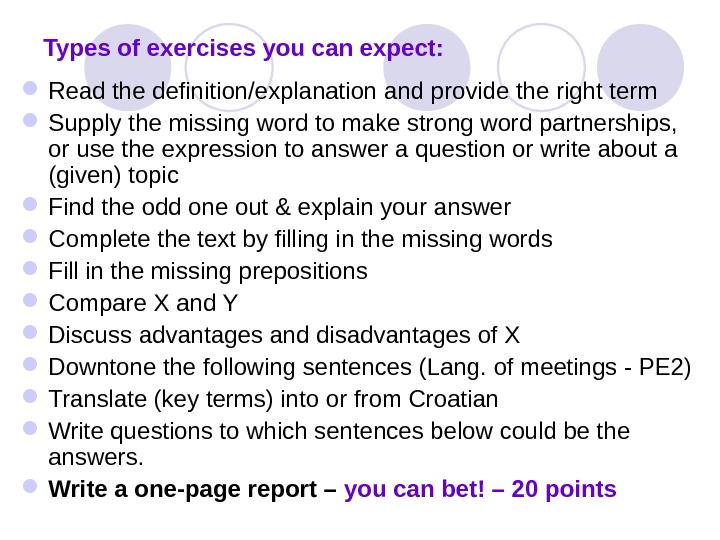
- Размер: 488 Кб
- Количество слайдов: 42
Описание презентации AUD ARS ALL BRL BGN BOB COP CNY по слайдам
 AUD ARS ALL BRL BGN BOB COP CNY CZK EUR EGP DKK HKD INR HUF JPY VEB USD CHF RUB PLN GBP HRK MKD XAU
AUD ARS ALL BRL BGN BOB COP CNY CZK EUR EGP DKK HKD INR HUF JPY VEB USD CHF RUB PLN GBP HRK MKD XAU
 WHAT FITS HERE? domestic ~ stable ~ foreign ~ weak ~ hard ~ convertible ~ common ~ national ~ (ex)change ~ convert ~ (to) buy/sell ~ devalue/revalue ~ peg/fix ~ (to) ~ rises/falls ~ floats ~ fluctuates
WHAT FITS HERE? domestic ~ stable ~ foreign ~ weak ~ hard ~ convertible ~ common ~ national ~ (ex)change ~ convert ~ (to) buy/sell ~ devalue/revalue ~ peg/fix ~ (to) ~ rises/falls ~ floats ~ fluctuates
 one word fit all: CURRENCY (n. ) Adjective + currency domestic ~ stable ~ foreign ~ weak ~ hard ~ convertible ~ common ~ national ~ Verb (vt*) + currency (object) (ex)change ~ convert ~ (to) buy/sell ~ devalue/revalue ~ peg/fix ~ (to) currency + verb (vi**) ~ rises/falls ~ floats ~ fluctuates *transitive – followed by a direct object **intransitive – no dir. object
one word fit all: CURRENCY (n. ) Adjective + currency domestic ~ stable ~ foreign ~ weak ~ hard ~ convertible ~ common ~ national ~ Verb (vt*) + currency (object) (ex)change ~ convert ~ (to) buy/sell ~ devalue/revalue ~ peg/fix ~ (to) currency + verb (vi**) ~ rises/falls ~ floats ~ fluctuates *transitive – followed by a direct object **intransitive – no dir. object
 Currencies the US dollar (USD / US $ ) the euro (EUR / €) the yen (JPY / ¥ ) the British pound (GBP / ₤) the kuna (HRK) the euro but 10. 000 euros The dollar has slipped by around 3% against the yen and the euro since November. ___________________________________________________________________ Their house is now worth 250. 000 euros. _______________________________________________________ For deposits in amount over USD 10. 000, EUR 10. 000 or PLN 50.
Currencies the US dollar (USD / US $ ) the euro (EUR / €) the yen (JPY / ¥ ) the British pound (GBP / ₤) the kuna (HRK) the euro but 10. 000 euros The dollar has slipped by around 3% against the yen and the euro since November. ___________________________________________________________________ Their house is now worth 250. 000 euros. _______________________________________________________ For deposits in amount over USD 10. 000, EUR 10. 000 or PLN 50.
 Introduction a country’s relative level of economic health. / Aside from factors / is one of the most important determinants of / such as interest rates and inflation, / the exchange rate Aside from factors such as interest rates and inflation, the exchange rate is one of the most important determinants of a country’s relative level of economic health.
Introduction a country’s relative level of economic health. / Aside from factors / is one of the most important determinants of / such as interest rates and inflation, / the exchange rate Aside from factors such as interest rates and inflation, the exchange rate is one of the most important determinants of a country’s relative level of economic health.
 Intro. continued which is critical to / play a vital role in / almost every free market economy / a country’s level of trade / Exchange rates / in the world. Exchange rates play a vital role in a country’s level of trade, which is critical to almost every free market economy in the world.
Intro. continued which is critical to / play a vital role in / almost every free market economy / a country’s level of trade / Exchange rates / in the world. Exchange rates play a vital role in a country’s level of trade, which is critical to almost every free market economy in the world.
 Exchange rate movements affect a nation’s trading relationships with other nations: makes / A higher currency / a country’s exports / cheaper / more expensive and / imports / in foreign markets. A higher* currency makes a country’s exports more expensive and imports cheaper in foreign markets. * currency appreciates When the exporter’s currency appreciates , exports are becoming less / more profitable for the exporters and less / more expensive for the importers.
Exchange rate movements affect a nation’s trading relationships with other nations: makes / A higher currency / a country’s exports / cheaper / more expensive and / imports / in foreign markets. A higher* currency makes a country’s exports more expensive and imports cheaper in foreign markets. * currency appreciates When the exporter’s currency appreciates , exports are becoming less / more profitable for the exporters and less / more expensive for the importers.
 Exchange rate movements affect a nation’s trading relationships with other nations: makes / A higher currency / a country’s exports / cheaper / more expensive and / imports / in foreign markets. A higher* currency makes a country’s exports more expensive and imports cheaper in foreign markets. * it appreciates When the exporter’s currency appreciates , exports are becoming less profitable for the exporters and more expensive for the importers.
Exchange rate movements affect a nation’s trading relationships with other nations: makes / A higher currency / a country’s exports / cheaper / more expensive and / imports / in foreign markets. A higher* currency makes a country’s exports more expensive and imports cheaper in foreign markets. * it appreciates When the exporter’s currency appreciates , exports are becoming less profitable for the exporters and more expensive for the importers.
 A lower currency / a country’s / makes / exports / and imports / cheaper / more expensive / in foreign markets. A lower* currency makes a country’s exports cheaper and its imports more expensive in foreign markets. * currency depreciates When the exporters’ currency depreciates , exports become _______ in the destination market.
A lower currency / a country’s / makes / exports / and imports / cheaper / more expensive / in foreign markets. A lower* currency makes a country’s exports cheaper and its imports more expensive in foreign markets. * currency depreciates When the exporters’ currency depreciates , exports become _______ in the destination market.
 A lower currency / a country’s / makes / exports / and imports / cheaper / more expensive / in foreign markets. A lower* currency makes a country’s exports cheaper and its imports more expensive in foreign markets. * currency depreciates When the exporters’ currency depreciates , exports become cheaper in the destination market. www. investopedia. com
A lower currency / a country’s / makes / exports / and imports / cheaper / more expensive / in foreign markets. A lower* currency makes a country’s exports cheaper and its imports more expensive in foreign markets. * currency depreciates When the exporters’ currency depreciates , exports become cheaper in the destination market. www. investopedia. com
 Exchange rates MK, U
Exchange rates MK, U
 Exchange rate is. . . (note: prepositions ) the amount of one currency that can be bought with another The exchange rate is 7. 4 kunas to the euro. The exchange rate is 5. 48 kunas to the USD. the price at which one currency can be bought a rate at which one currency can be exchanged into / for another currency. value one currency in terms of other € 1 = HRK 7. 4 the conversion rate of every € to HRK
Exchange rate is. . . (note: prepositions ) the amount of one currency that can be bought with another The exchange rate is 7. 4 kunas to the euro. The exchange rate is 5. 48 kunas to the USD. the price at which one currency can be bought a rate at which one currency can be exchanged into / for another currency. value one currency in terms of other € 1 = HRK 7. 4 the conversion rate of every € to HRK
 Why do companies, institutions and people buy currencies? How is the value (the exchange rate) of the money in your pocked determined? Has the value HRK increased or decreased in the past few months? Has it increased or decreased since the summer? Why? Is the exchange rate of HRK fixed? What do we call this type of exchange rate? FLOATING Is it freely floating?
Why do companies, institutions and people buy currencies? How is the value (the exchange rate) of the money in your pocked determined? Has the value HRK increased or decreased in the past few months? Has it increased or decreased since the summer? Why? Is the exchange rate of HRK fixed? What do we call this type of exchange rate? FLOATING Is it freely floating?
 Which of the three rates are described below? FIXED, MANAGED FLOATING or FLOATING E. R. ? 1. a rate which is set by the govt. (central bank) only. . . . 2. a rate which is determined by the private market through supply and demand. . . 3. its value will decrease only if demand is low (and vice-versa). . . . 4. it does not change before it is centrally decided. . . 5. if the rate changes more than the central bank allows, the bank intervenes (buys or sells the currency). . . 6. based on the free market only. . . . 7. its value will rise only if demand is high. . . . 8. a combination of the other two types. . . 9. example of intervention in the economy. . .
Which of the three rates are described below? FIXED, MANAGED FLOATING or FLOATING E. R. ? 1. a rate which is set by the govt. (central bank) only. . . . 2. a rate which is determined by the private market through supply and demand. . . 3. its value will decrease only if demand is low (and vice-versa). . . . 4. it does not change before it is centrally decided. . . 5. if the rate changes more than the central bank allows, the bank intervenes (buys or sells the currency). . . 6. based on the free market only. . . . 7. its value will rise only if demand is high. . . . 8. a combination of the other two types. . . 9. example of intervention in the economy. . .
 Which of the three rates are described below? FIXED, MANAGED FLOATING or FLOATING E. R. ? 1. a rate which is set by the govt. only FIXED E. R. 2. a rate which is determined by the private market through supply and demand FLOATING E. R. 3. its value will decrease only if demand is low (and vice-versa) FLOATING E. R. 4. it does not change before it is centrally decided FIXED 5. if the rate changes more than the central bank allows, the bank intervenes (buys or sells the currency) MANAGED FLOATING E. R. 6. based on the free market only FLOATING 7. its value will rise only if demand is high FLOATING 8. a combination of the other two types MANAGED FLOAT. 9. example of intervention in the economy FIXED E. R. , MANAGED FLOATING E. R. www. investopedia. com
Which of the three rates are described below? FIXED, MANAGED FLOATING or FLOATING E. R. ? 1. a rate which is set by the govt. only FIXED E. R. 2. a rate which is determined by the private market through supply and demand FLOATING E. R. 3. its value will decrease only if demand is low (and vice-versa) FLOATING E. R. 4. it does not change before it is centrally decided FIXED 5. if the rate changes more than the central bank allows, the bank intervenes (buys or sells the currency) MANAGED FLOATING E. R. 6. based on the free market only FLOATING 7. its value will rise only if demand is high FLOATING 8. a combination of the other two types MANAGED FLOAT. 9. example of intervention in the economy FIXED E. R. , MANAGED FLOATING E. R. www. investopedia. com
 Read EXCHANGE RATES, pg. 1 MK, U 26, p 128 and match with a heading The Bretton-Woods Agreement of 1944 established ______ exchange rates, defined in terms of ______ and the US dollar. Between 1944 and 1971 many currencies were _______ the US dollar, i. e. their parities with the US dolar were fixed. One US dollar was a promissory note issued by the US Tresury and could be exchanged for 1/35 th of an ____ of gold. Under this system, fixed exchange rates could only be adjusted (revalued or _____) with the agreement of the _____________.
Read EXCHANGE RATES, pg. 1 MK, U 26, p 128 and match with a heading The Bretton-Woods Agreement of 1944 established ______ exchange rates, defined in terms of ______ and the US dollar. Between 1944 and 1971 many currencies were _______ the US dollar, i. e. their parities with the US dolar were fixed. One US dollar was a promissory note issued by the US Tresury and could be exchanged for 1/35 th of an ____ of gold. Under this system, fixed exchange rates could only be adjusted (revalued or _____) with the agreement of the _____________.
 EXCHANGE RATES, pg. 1 MK, p 128 – HEADING: Gold convertibility The Bretton-Woods Agreement of 1944 established fixed exchange rates, defined in terms of gold and the US dollar. Between 1944 and 1971 many currencies were pegged against the US dollar, i. e. their parities with the US dolar were fixed. One US dollar was a promissory note issued by the US Tresury and could be exchanged for 1/35 th of an ounce of gold. Under this system, fixed exchange rates could only be adjusted (revalued or devalued )with the agreement of the International Monetary Fund.
EXCHANGE RATES, pg. 1 MK, p 128 – HEADING: Gold convertibility The Bretton-Woods Agreement of 1944 established fixed exchange rates, defined in terms of gold and the US dollar. Between 1944 and 1971 many currencies were pegged against the US dollar, i. e. their parities with the US dolar were fixed. One US dollar was a promissory note issued by the US Tresury and could be exchanged for 1/35 th of an ounce of gold. Under this system, fixed exchange rates could only be adjusted (revalued or devalued )with the agreement of the International Monetary Fund.
 The Bretton-Woods system of gold _____ and pegging ____ the dollar was abandoned in 1971, because following inflation, the Federal Reserve did not have enough gold to _____ its currency. Say which: devaluated or revaluated An overvalued currency had to be _____. An undervalued currency had to be _____. Currencies could only be adjusted with the agreement of the ______.
The Bretton-Woods system of gold _____ and pegging ____ the dollar was abandoned in 1971, because following inflation, the Federal Reserve did not have enough gold to _____ its currency. Say which: devaluated or revaluated An overvalued currency had to be _____. An undervalued currency had to be _____. Currencies could only be adjusted with the agreement of the ______.
 The Bretton-Woods system of gold convertibility and pegging against the dollar was abandoned in 1971, because following inflation, the Federal Reserve did not have enough gold to guarantee its currency. Say which: devaluated or revaluated An overvalued currency had to be devaluated. An undervalued currency had to be revaluated. Currencies could only be adjusted with the agreement of the IMF.
The Bretton-Woods system of gold convertibility and pegging against the dollar was abandoned in 1971, because following inflation, the Federal Reserve did not have enough gold to guarantee its currency. Say which: devaluated or revaluated An overvalued currency had to be devaluated. An undervalued currency had to be revaluated. Currencies could only be adjusted with the agreement of the IMF.
 Please, read pg. 2 & match with a heading Most western countries have had _____ exchange rates ever since 1971. This means that exchange rates are determined by the market ____ — the quantities _______ and ______. If demand exceeds supply, the price will ______; if supply exceeds demand, the price of a currency will _______. Milton Friedman, for example, was a _____ of freely floating exchange rates. He ____ that currencies would automatically settle at stable rates which would ______ underlying economic _____. However, proponents of freely floating exchange rates ______ the impact of speculation.
Please, read pg. 2 & match with a heading Most western countries have had _____ exchange rates ever since 1971. This means that exchange rates are determined by the market ____ — the quantities _______ and ______. If demand exceeds supply, the price will ______; if supply exceeds demand, the price of a currency will _______. Milton Friedman, for example, was a _____ of freely floating exchange rates. He ____ that currencies would automatically settle at stable rates which would ______ underlying economic _____. However, proponents of freely floating exchange rates ______ the impact of speculation.
 Pg. 2 – heading: Market forces Most western countries have had floating exchange rates ever since 1971. This means that exchange rates are determined by the market forces — the quantities bought and sold. If demand exceeds supply, the price will rise ; if supply exceeds demand, the price of a currency will fall. Milton Friedman, for example, was a proponent of freely floating exchange rates. He argued that currencies would automatically settle at stable rates which would reflect underlying economic conditions. However, proponents of freely floating exchange rates underestimated the impact of speculation.
Pg. 2 – heading: Market forces Most western countries have had floating exchange rates ever since 1971. This means that exchange rates are determined by the market forces — the quantities bought and sold. If demand exceeds supply, the price will rise ; if supply exceeds demand, the price of a currency will fall. Milton Friedman, for example, was a proponent of freely floating exchange rates. He argued that currencies would automatically settle at stable rates which would reflect underlying economic conditions. However, proponents of freely floating exchange rates underestimated the impact of speculation.
 Read pg. 3 & match with a heading PPP stands for _______. Purchasing power – the ability to buy things Parity – the state of being the same or equal If HRK and GBP have PPP, an amount of HRK needed to buy particular goods in Croatia will buy ____ amount of goods in the United Kingdom when exchanged into GBP. If floating exchange rates gave PPP, the cost of a given selection of goods would be the same in different countries. Floating exchange rates do not give PPP because of currency ______. As much as ____% of world’s currency transactions are purely speculative.
Read pg. 3 & match with a heading PPP stands for _______. Purchasing power – the ability to buy things Parity – the state of being the same or equal If HRK and GBP have PPP, an amount of HRK needed to buy particular goods in Croatia will buy ____ amount of goods in the United Kingdom when exchanged into GBP. If floating exchange rates gave PPP, the cost of a given selection of goods would be the same in different countries. Floating exchange rates do not give PPP because of currency ______. As much as ____% of world’s currency transactions are purely speculative.
 Pg. 3 – heading: Parity and speculation PPP stands for purchasing power parity. Purchasing power – the ability to buy things Parity – the state of being the same or equal If HRK and GBP have PPP, an amount of HRK needed to buy particular goods in Croatia will buy the same amount of goods in the United Kingdom when exchanged into GBP. If floating exchange rates gave PPP, the cost of a given selection of goods would be the same in different countries. Floating exchange rates do not give PPP because of currency speculations. As much as 95 % of world’s currency transactions are purely speculative.
Pg. 3 – heading: Parity and speculation PPP stands for purchasing power parity. Purchasing power – the ability to buy things Parity – the state of being the same or equal If HRK and GBP have PPP, an amount of HRK needed to buy particular goods in Croatia will buy the same amount of goods in the United Kingdom when exchanged into GBP. If floating exchange rates gave PPP, the cost of a given selection of goods would be the same in different countries. Floating exchange rates do not give PPP because of currency speculations. As much as 95 % of world’s currency transactions are purely speculative.
 Please, read pgs. 4 & 5 match with headings Match to create collocations used in pgs. 4&5 intervene currency reserves hedge contracts raw planning futures markets forward of the Euro export against currency fluctuations establishment materials foreign in exchange markets
Please, read pgs. 4 & 5 match with headings Match to create collocations used in pgs. 4&5 intervene currency reserves hedge contracts raw planning futures markets forward of the Euro export against currency fluctuations establishment materials foreign in exchange markets
 Pg. 4 – Counteracting speculation Pg. 5 – Market interventions Match to create collocations used in pgs. 4&5 intervene in exchange markets reserves Hedge against currency fluctuations raw materials futures contracts forward planning export markets establishment of the Euro foreign currency
Pg. 4 – Counteracting speculation Pg. 5 – Market interventions Match to create collocations used in pgs. 4&5 intervene in exchange markets reserves Hedge against currency fluctuations raw materials futures contracts forward planning export markets establishment of the Euro foreign currency
 Comprehension: Write questions 1. _____ gold convertibility? 2. ____ the Federal Reserve end the system of gold convertibility in 1971? OR ____ gold convertibility end in 1971? 3. ____ a floating exchange rate determined? 4. _____ happen if there was PPP? OR _____ happen if currencies were correctly valued? 5. ____ speculators buy foreign currencies? 6. _______ of world currency transations ___ purely speculative?
Comprehension: Write questions 1. _____ gold convertibility? 2. ____ the Federal Reserve end the system of gold convertibility in 1971? OR ____ gold convertibility end in 1971? 3. ____ a floating exchange rate determined? 4. _____ happen if there was PPP? OR _____ happen if currencies were correctly valued? 5. ____ speculators buy foreign currencies? 6. _______ of world currency transations ___ purely speculative?
 Comprehension: Write questions 1. What was gold convertibility? 2. Why did the Federal Reserve end the system of gold convertibility in 1971? OR Why did gold convertibility end in 1971? 3. How is a floating exchange rate determined? 4. What would happen if there was PPP? What would happen if currencies were correctly valued? 5. Why do speculators buy foreign currencies? 6. What proportion of world currency transations are purely speculative?
Comprehension: Write questions 1. What was gold convertibility? 2. Why did the Federal Reserve end the system of gold convertibility in 1971? OR Why did gold convertibility end in 1971? 3. How is a floating exchange rate determined? 4. What would happen if there was PPP? What would happen if currencies were correctly valued? 5. Why do speculators buy foreign currencies? 6. What proportion of world currency transations are purely speculative?
 7. ____ companies ____ to protect themselves against currency fluctuations? 8. ____ governments and central banks attempt to influence the value of their currency? 9. _____ attempts to “manage” a floating exchange rate have a limited succes? 9. _____ governments’ or central banks’ attempts to influence exchange rates not very successful?
7. ____ companies ____ to protect themselves against currency fluctuations? 8. ____ governments and central banks attempt to influence the value of their currency? 9. _____ attempts to “manage” a floating exchange rate have a limited succes? 9. _____ governments’ or central banks’ attempts to influence exchange rates not very successful?
 7. How can companies try to protect themselves against currency fluctuations? 8. How can governments and central banks attempt to influence the value of their currency? 9. Why do attempts to “manage” a floating exchange rate have a limited succes? OR Why are governments’ or central banks’ attempts to influence exchange rates not very successful? Vocabulary , p
7. How can companies try to protect themselves against currency fluctuations? 8. How can governments and central banks attempt to influence the value of their currency? 9. Why do attempts to “manage” a floating exchange rate have a limited succes? OR Why are governments’ or central banks’ attempts to influence exchange rates not very successful? Vocabulary , p
 Vocabulary , p 129 1 revaluate 2 devaluate 3 floating 4 proponents 5 depreciate 6 appreciate 7 hedge 8 fluctuations 9 futures contracts
Vocabulary , p 129 1 revaluate 2 devaluate 3 floating 4 proponents 5 depreciate 6 appreciate 7 hedge 8 fluctuations 9 futures contracts
 Vocabulary , p 129 1 revaluate 2 devaluate 3 floating 4 proponents 5 depreciate 6 appreciate 7 hedge 8 fluctuations 9 futures contracts
Vocabulary , p 129 1 revaluate 2 devaluate 3 floating 4 proponents 5 depreciate 6 appreciate 7 hedge 8 fluctuations 9 futures contracts
 Vocabulary , p 129 1 revaluate 2 devaluate 3 floating 4 proponents 5 depreciate 6 appreciate 7 hedge 8 fluctuations 9 futures contracts
Vocabulary , p 129 1 revaluate 2 devaluate 3 floating 4 proponents 5 depreciate 6 appreciate 7 hedge 8 fluctuations 9 futures contracts
 Listening 1: Currency flows and the Tobin Tax 1. “ Hot money” is s______ money that is invested in a c______ for a very short time, which means that it is f____ in and out of a country very q____. 2. I_____ u_____ and falling o_____. 3. Tobin Tax is a very s_____ t_____ on currency p______ and currency s_______. It is d_____ to reduce c______ s____.
Listening 1: Currency flows and the Tobin Tax 1. “ Hot money” is s______ money that is invested in a c______ for a very short time, which means that it is f____ in and out of a country very q____. 2. I_____ u_____ and falling o_____. 3. Tobin Tax is a very s_____ t_____ on currency p______ and currency s_______. It is d_____ to reduce c______ s____.
 Listening 1: Currency flows and the Tobin Tax 1. “ Hot money” is s peculative money that is invested in a currency for a very short time, which means that it is flowing in and out of a country very q uickly. 2. I ncreased u nemployment and falling o utput. 3. Tobin Tax is a very s mall tax on currency purchase and currency selling. It is designed to reduce currency speculations.
Listening 1: Currency flows and the Tobin Tax 1. “ Hot money” is s peculative money that is invested in a currency for a very short time, which means that it is flowing in and out of a country very q uickly. 2. I ncreased u nemployment and falling o utput. 3. Tobin Tax is a very s mall tax on currency purchase and currency selling. It is designed to reduce currency speculations.
 Listening 1: Currency flows and the Tobin Tax – cont. 4. “Highly l_______” currency t______ is b______ or selling currency with b______ money. 5. It would probably r_____ or “d_____ down” c______ trading and c____ f____. 6. ______ makes global c____ possible.
Listening 1: Currency flows and the Tobin Tax – cont. 4. “Highly l_______” currency t______ is b______ or selling currency with b______ money. 5. It would probably r_____ or “d_____ down” c______ trading and c____ f____. 6. ______ makes global c____ possible.
 Listening 1: Currency flows and the Tobin Tax – cont. 4. “Highly l everaged” currency t rading is b uying or selling currency with b orrowed money. 5. It would probably r educe or “d ampen down” currency trading and currency fluctuations. 6. ICT makes global coordination possible. ICT is i____ and c____ t____.
Listening 1: Currency flows and the Tobin Tax – cont. 4. “Highly l everaged” currency t rading is b uying or selling currency with b orrowed money. 5. It would probably r educe or “d ampen down” currency trading and currency fluctuations. 6. ICT makes global coordination possible. ICT is i____ and c____ t____.
 Listening 1: Currency flows and the Tobin Tax – cont. 4. “Highly l everaged” currency t rading is b uying or selling currency with b orrowed money. 5. It would probably r educe or “d ampen down” currency trading and currency fluctuations. 6. ICT makes global coordination possible. ICT is information and computer technology.
Listening 1: Currency flows and the Tobin Tax – cont. 4. “Highly l everaged” currency t rading is b uying or selling currency with b orrowed money. 5. It would probably r educe or “d ampen down” currency trading and currency fluctuations. 6. ICT makes global coordination possible. ICT is information and computer technology.
 Listening 2: Developing Africa 1. Because they won’t get a s____ r______ of return, or a p_______. 2. Africa would get a s____ social rate of r_______: better education, better economic g_____, better standards of living, longer l_______ e_____.
Listening 2: Developing Africa 1. Because they won’t get a s____ r______ of return, or a p_______. 2. Africa would get a s____ social rate of r_______: better education, better economic g_____, better standards of living, longer l_______ e_____.
 Listening 2: Developing Africa 1. Because they won’t get a sufficient rate of return, or a profit. 2. Africa would get a significant social rate of return : better education, better economic growth , better standards of living, longer life expectancy.
Listening 2: Developing Africa 1. Because they won’t get a sufficient rate of return, or a profit. 2. Africa would get a significant social rate of return : better education, better economic growth , better standards of living, longer life expectancy.
 1 st Progress test , 18 April, 2011 12. 00 — group 11_1 13. 00 – group 11_2 Topics covered: → Reader, p 1: all but Graph Meetings (R) Description & Finance Report writing (R) Marketing Products (R + MK 11) Marketing (R + MK 12) Advertising (R + MK 13) Trade Retail and Wholesale, visible — invisible (R) International trade, barriers to free trade (R + MK 27) Banking (R + MK 14) Insurance (R) Central banking (R) Exchange rates (MK 26)
1 st Progress test , 18 April, 2011 12. 00 — group 11_1 13. 00 – group 11_2 Topics covered: → Reader, p 1: all but Graph Meetings (R) Description & Finance Report writing (R) Marketing Products (R + MK 11) Marketing (R + MK 12) Advertising (R + MK 13) Trade Retail and Wholesale, visible — invisible (R) International trade, barriers to free trade (R + MK 27) Banking (R + MK 14) Insurance (R) Central banking (R) Exchange rates (MK 26)
 Preparing for the written and oral exam read each relevant text underline unknown words/expressions find their meaning (dict. , note-book, slides, web, . . . ) make sure you understand all the text consider the various related texts and materials as elements contributing to your general understanding of a certain topic see which of the words/expressions in the texts were important for this topic (slides, notebook, vocabulary sections in MK and Reader) explain their meaning in simple English retell the main message of each text orally be prepared to discuss various topics and present your personal views Think what ex. could be expected in the test
Preparing for the written and oral exam read each relevant text underline unknown words/expressions find their meaning (dict. , note-book, slides, web, . . . ) make sure you understand all the text consider the various related texts and materials as elements contributing to your general understanding of a certain topic see which of the words/expressions in the texts were important for this topic (slides, notebook, vocabulary sections in MK and Reader) explain their meaning in simple English retell the main message of each text orally be prepared to discuss various topics and present your personal views Think what ex. could be expected in the test
 Types of exercises you can expect: Read the definition/explanation and provide the right term Supply the missing word to make strong word partnerships, or use the expression to answer a question or write about a (given) topic Find the odd one out & explain your answer Complete the text by filling in the missing words Fill in the missing prepositions Compare X and Y Discuss advantages and disadvantages of X Downtone the following sentences (Lang. of meetings — PE 2) Translate (key terms) into or from Croatian Write questions to which sentences below could be the answers. Write a one-page report – you can bet! – 20 points
Types of exercises you can expect: Read the definition/explanation and provide the right term Supply the missing word to make strong word partnerships, or use the expression to answer a question or write about a (given) topic Find the odd one out & explain your answer Complete the text by filling in the missing words Fill in the missing prepositions Compare X and Y Discuss advantages and disadvantages of X Downtone the following sentences (Lang. of meetings — PE 2) Translate (key terms) into or from Croatian Write questions to which sentences below could be the answers. Write a one-page report – you can bet! – 20 points

